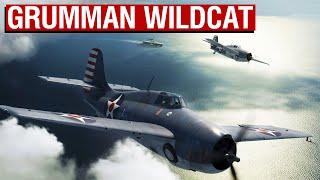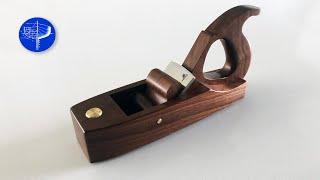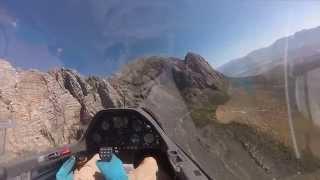
The Unloved Pacific Hero - Grumman F4F Wildcat | Aircraft History #97
Комментарии:

Loved the wildcat. Thatch weave 4 life!
Ответить
Ww2 planes were the best
Ответить
unsung heroes, P-40, Wildcat and the Hurricane, held the line and turned the tide. Its the Mechanic not the tools, thanks to our brave heroes
Ответить
I saw the martlet at the fleet air arm museum, it gets its own space in hall 2 while the f6f they have has its wings folded up
Ответить
Thank you. Interesting and well done.
Ответить
Beer and mind that a lot of the success that was according to the second generation of American fighters was enabled by the fact that many of the experience japanese pilots Had been shot down by Wildcats And warhawks. Also beer and mind that the A6M2 Zero Was actually a tad slower than the F4F-3. Eric Bergerac in Fire in the Sky does a great job of pointing out some of the other advantages the American planes had. The Wildcat was better at altitude and the P-40 could out-turn the Zero at speeds over 275 mph. Both ships had more effective armament for Pacific combat.
Ответить
Huh, no mention of the belly windows. Got the same type of thing on my Allegro to be able to see my blind spot on the right side from the drivers seat. Small but nice to have!
Ответить
I was fortunate enough to see a Wildcat in flying condition at my state's air show. While the Hellcat got all the glory, it was the Wildcat that held the line early in the Pacific war. Sure, it was slower and less maneuverable than the Zero, but what it lacked in speed, it made up for in armament and armor. The Wildcat could absorb a beating and still make it home. And after Grumman switched entirely to Hellcat production, GM took over Wildcat production (designated the FM2), as the Hellcat was too big for escort carriers.
Ответить
Not the best plane in WW2, but you actually had a chance to win, which is better than many of the other early American planes.
Ответить
I am really impressed with the details you have presented. It must take a lot of time to dig up all the data. Thanks so much for doing this. I really enjoy them.
Ответить
Unloved Hell, I've loved that little fighter since childhood.. it took on the Best and Above and beyond held it's own.
Ответить
Didn't even give a passing statement about how useful the Wildcat was during the battle of Samar where it helped harassed the Japanese center force into retreating. Kinda disappointed in that.
The said the Wildcat is my most favorite Navel plane of WWII. It may not have been the best but it was a hard worker and held the line very well.

The change to six guns vs four was by British recomendation from European experiance, if I remember correctly. Four guns would have been adequate against the unarmored Japanese planes. The extra guns and wing folding mechanism added a lot of weight and reduced performance.
The difference in the Franch throttle contorls was that they opperated backwards from US planes. Throttle foward for full power, back for idle in US and British but full forward was for idle and back for full power in the French planes. This was also true for the P-75 Hawks the French bought for their airforce.
In 1942 the Fleet Air Arm was desperate for carrier aircraft. They were all obsolete in cluding the Swordfish, but it's replacement was worse so the stringbag had to soldier on and be glad they did not have to go against the 1942 IJN carriers with what they had.
The poor ability of the F4F for carrier escort roles was procedural the fighters did not wait for the bombers to take off before heading to the target because of fuel/range concerns. Better doctrine came later.
The F4Fs at Guadalcanal had an advantage. Due to the flying time from Rabaul and reports from Coast Watchers and radar they knew when the Japanese would be arriving, about noon, and had plenty of time to get the slugish climbing Wildcats to a good attack altitued before the Japanese arrived without worrying about running low on fuel waiting.
The FM-2, I believe, had a large single row radial engine rather than the twin row radial of the F4Fs. Cheaper, and ligther than the original engine. The rockets were also useful for the British attacking U-boats.

This was an outstanding and informative summary video of the wildcat family.
Ответить
Brought a tear to my eye when I saw one at an airshow a few years back
Ответить
They were the ugly duckling
Ответить
Ferocious. Tough. Capable. Underappreciated.
Like the P40, the Hurricane, the Buffalo, (a fine aircraft from the last generation), it is often forgotten, eclipsed by the superb aircraft that followed them. But, please, don't forget, who bought the time needed: the brave young men who, in essence, followed Lord Nelson's maxim: you must fight your ship.
Know what its capabilities are, and execute your mission.

Never a sleek looking bird but it did its job well like most of us in a 9 to 5 job😎🇦🇺👌
Ответить
The F4F stayed in production because it could work off escort carriers. But these were built by Eastern Aircraft a division of G.M.
Ответить
The F6-F Hellcat was, by every measure the better aircraft. But it didn't enter the war until 1943. It was Wildcats that won the Battle of the Coral Sea. It was Wildcats that chased Admiral Kurita out of Leyte Gulf. The idea that the Wildcat was useless against the A6M Zero is also garbage. Navy pilots learned to use the Wildcat against the Zero. The Thatch Weave, refusing to dogfight the Zeros, but attacking them in a dive. This is the aircraft that won the war in the Pacific, IMHO! It held the line! ^_^
Ответить
Very informative video. I had models of the Wildcat, Hellcat and Corsair hanging in my bedroom as a teenager. I love their history.
Ответить
The ugliest ww2 plane.
Ответить
I flew for the Marines toward the end of the RVN “police” action. If I could have done it all over again 30 years earlier I would have gladly flown the Wildcat.
Ответить
Every time I learn something new about the Wildcat, I gain more respect for the truly remarkable fighter that it was.
Ответить
I always thought of the Wildcat as pugnacious.
Ответить
Although the Grumman F4F Wildcat 🦅 was obsolete by The early years of WW2 she was all that the navy had and, she did sterling service in the hands of experienced pilots and found an edge on her advisory the Mitsubishi A6M Zero Sen 😉👍🤠
Ответить
Although the Grumman F4F Wildcat 🦅 was obsolete by The early years of WW2 she was all that the navy had and, she did sterling service in the hands of experienced pilots and found an edge on her advisory the Mitsubishi A6M Zero Sen 😉👍🤠
Ответить
Always liked this plane ever since reading Wake Island by Duane Schultz. Good work on this video!
Ответить
Let's not forget the aerial tactics like the Thach weave that was developed for the F4F-4.
Ответить
The one thing the Wildcat and Buffalo had is that they're thicc and barrel shaped. To those who think this aircraft is a piece of junk, think again. The Wildcat is doing what it's supposed to do and it did it's job admirably and a reliable workhorse for the escort carriers.
Ответить
👍
Ответить
It's a shame how little recognition this true Zero Killer gets.
The F4F had to contend with the actual bulk of elite IJN aviatiors, it wasn't until after Midway, Guadalcanal, etc, when the Zero's weaknesses were all but common public knowledge (thanks to no more large scale IJN Carrier ops & IJN pilots, the Akutan Zero and "survivor stories") that the Hellcat came in and, to put it in gamer terms, more or less seal clubbed noobs with 18:1 ratio, which was actually 10:1 vs Zero's, and 8:1 vs everything else, including planes that had scant defense against any fighter, let alone a powerhouse sporting 2000hp (2200hp later on in the F6F-5) & 6 .50's.
The F4F itself (and it's pilots, as it turned out) were more than up to the task, it was by no means a slouch in maneuvers, if Wildcat acrobatic videos are anything to go by.
The F4F-3 at 3500kg (assuming it used some fuel before getting into a dogfight) wasn't too much heavier than the Zero @ 2796kg, it's engine was about the same power as the Zero too.
The Wildcat gets dizzed for being heavy, but we also have to remember the Japanese even went so far as to invent a new alloy to keep weight down so they could stay competitive despite lagging behind in engine technology.
And even for all that, the prototype Wildcat was almost 300kg lighter than the Zero, it was the addition of armor and self sealing fuel tanks that added weight and impaired low speed maneuverability, which as we all know, the F6F did not improve on either.
The F4F was maneuverable enough for team defensive tactics, and scored 3.1 KD vs Zero's at Midway, that's good enough even today.
And that KD that actually improved to 6.1 at Guadalcanal & other islands, vs A6M3.
Yes, the Hellcat scored an impressive 10.1 against the Zero, but again, by that time most of the experienced IJN aviator cadre was already much depleted by savvy Wildcat's.
The Zero was good, but not as good as many claim, and the Japanese knew it, it was designed as a stop interim design while the Japanese were still gunning for quick maneuver warfare, not a war of attrition, as reflected in it's lack of armor and efficient self-sealing fuel tanks.
The Japanese Navy knew the war was likely to drag on, "Sleeping giant" and all that, and was already "getting quotes" for it's intended successor, the A7M Reppu, design on it started already as the first Zero's rolled off the assembly line, much like the F6F was being designed as the F4F entered service.
The difference is, the Japanese couldn't get the A7M Reppu rolled out in time, because they didn't have the required NK9 Homare 2000hp engine fully fleshed out yet, which was too powerful to be added to the Zero, there was only so much they could do with the lightweight & fragile Zero, one variant, the A6M8 Model 64, saw two prototypes built, with the 1560hp Kinsei 62 engine, but with many modifications, and could not be put into production due to the lack of industrial capacity & chaotic and desperate situation at that point.
Add to that, after Coral Sea, Santa Cruz & Midway, they didn't even have the carriers to justify a brand new carrier fighter design like the A7M Reppu.
So they went with a modified design of the N1K "Jake" floatplane instead, the N1K1/N1K1-Ja/N1K2-Ja "George", but again, by that time their much diminished industrial capabilities (which was nothing to write home about even pre-war) meant they couldn't equip enough squadrons fast enough to make a big difference, so it was already much too late.

Superb work!
Ответить
The wildcat is not a bad airplane, but it always gets compared to the Zero and other Jap airplanes it had to fight.
Ответить
Grumman always builds the best planes in the world. I loved the Grumman A6E Intruder. I worked on them 1976 - 1980. VA-85, USS Forrestal. 🫡 🇺🇸
Ответить
everyone says this thing is unloved but it is quite literally one of my favorite planes ever
Ответить
The Wildcat Was A Rugged Airplane. But It Just Couldn't Match With The Zero!
Ответить
Bollocks to the Jersey Wankers Mate !
Ответить
Unloved by idiots, maybe. Yeah, the Hellcat shot down the most enemy aircraft in WW2 was definitely a welcome upgrade but when Taffy 3 had the world's largest remaining battleship baring down on them, who was the one doing strafing runs while their pilots shot their pistols out the cockpit at the bridge? The Wildcat. Because the Hellcat was too fat for escort carriers. And for nearly two years, the Wildcat and her inexperienced pilots shot down many superior aircraft and their pilots with years of experience. Which should've been a red flag. If the Americans and their inferior planes were still holding up against their betters, what would happen when the Americans inevitably got planes that equaled theirs?
Then again, Japanese higher command weren't the smartest people in the shed if the IJA generals that still thought they could retake Guadacanal while their troops on the island were literally rotting away due to the inability to resupply them are any indication.
Now if you excuse me, Imma go play with my Wildcat in War Thunder.

Atleast it had other more powerful update version to give it some fighting chances, the FM2 wildcats.
American largely prefer the "Boom & Zoom" tactic rather than "Turning fight" unless you are in the Corsair or Hellcats. Plus yes the "charge attack" where most Americans fighter aircraft (sorry p-51 mustang) are meant to be, one of which have to go down, and usually the opposition will be First

"Unloved"? The Wildcat may have lacked the speed and maneuverability of the famous Japanese Zero, but it was still by far the best carrier-based fighter that the US Navy had available to them at that time. It was also very well-liked by the Royal Navy. The Royal Navy received their first Wildcats ("Martlets") by way of a French production order which became diverted to Britain following the 1940 Fall of France. However, once they began to get Wildcats, the British liked them so well that they could not get enough of them.
Ответить
Its amazing to think, when its given some thought anyway, just how good this was when its immediate predecessors in every fleet were either (a) biplanes (b) oddballs (c) had fixed undercarriages or (d) two-seaters and in some cases, combinations of all four.
Or put it another way . . . . had the Kriegsmarine been able to field even 2 or 3 CVE-type carriers with even 10 ready and 2-3 spare F4F-class fighters, perhaps 3-4 navalised Ju-87's & a pair of Ar-196s on/around late-1940 to early-1941 then the War might have been very different indeed.

アメリカ人よ、そろそろ、インディアンに国土を返還して
故郷、アイルランドとかに、帰ったらいいのに。😮

Good too see the Wildcat getting a good press. Fond memories of one on the UK airshow circuit in the 1980s.
Ответить
My father was an TBM Avenger (torpedo bomber) pilot on "jeep" (CVE) carriers in the Pacific. Jeep carriers were too small to handle Hellcats and Corsairs, so their fighter component was made up of FM-2 Wildcats, so my father got to fly them too.
I can remember him telling me how well they handled and that flying them was like strapping on a pair of wings.
He didn't seem to think that an alert, experienced Wildcat pilot was at much of a disadvantage against the Zero. He always said that lack of attention and focus were the real killers.

The deeper the dive the better. Even the skin gauge is interesting.
Ответить
The wildcat and SBD basically laid the foundation for our victory in 1942.
Ответить
It's a shame that the Wildcat didn't get the recognition it deserved. It bore the brunt of the Pacific Air war and held the line against a much more agile opponent. I'm not sure if he got the kill to lost ratio correct but from what I researched, it was 6.9 to 1. That is a very respectable ratio even for a plane that many considered problematic despite the strengths it had. One was it saved many pilots lives that otherwise been would have been lost. I think many of those pilots survived and went to the F6F with the lessons learned.
Ответить

























